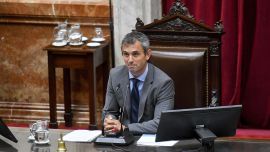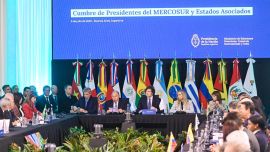The Central Bank’s fight against inflation is upending the local bond market and squeezing government finances as Argentina struggles to regain traction while the pandemic rages on.
Long known as some of the world’s most prolific money printers, Argentine policy makers are cutting back on the largesse in an effort to curb inflation running at more than 40 percent a year. While the move toward orthodoxy has often been urged by economists, the timing is difficult. Slower expansion of the money supply over the past six months has cut liquidity and sapped demand for debt, pushing up interest rates and making it harder for the government to fund itself given its lack of access to overseas markets.
The policy clash between the Central Bank and Treasury means the government has had difficulty raising pesos from recent sales in the local market, even as spending climbs ever higher to offset the economic effects of coronavirus lockdowns and appeal to voters before congressional elections set for October. Now, less than two years after Argentina emerged from its last default on local debt, investors are eyeing the situation with trepidation, with some increasingly concerned it isn’t sustainable over the long term.
“There is an inconsistency between fiscal and monetary policy,” said Juan Manuel Pazos, the chief economist at TPCG Valores in Buenos Aires. He said a debt auction today, at which the government will seek to sell inflation-linked bonds and other securities as 123 billion pesos (US$1.3 billion) of notes come due, will provide a test of investor demand.
A central bank spokesman declined to comment. An Economy Ministry spokesman didn’t immediately reply to a request for comment.
For years economists and international finance officials urged Argentina to get a handle on inflation by tightening the money supply and paring back government spending. While the United States and much of the developed world has gone decades without seeing significant price pressures even amid huge increases in the money supply and plenty of deficit spending, fear of inflation is so ingrained among Argentines after multiple currency and economic crises that any signs of trouble ahead tend to ring alarm bells.
And to be sure, the 52 percent growth in Argentina’s money supply over the past year is still very high. But the slowdown in money printing has been drastic. The annual rate of expansion was as high as 81 percent in October.
Meanwhile, President Alberto Fernández’s goal of paring the budget deficit excluding interest payments to 4.2 percent of gross domestic product this year from 6.5 percent last year now seems like it will be hard to meet amid pandemic-related spending. The Peronist leaer announced new aid measures in recent weeks, including extra payments for social-service beneficiaries and a one-time bonus for health-care workers. Last year, the deficit including interest payments totalled 8.5 percent of GDP.
So with foreign markets effectively closed to Argentina and amid delayed talks with the International Monetary Fund, the country has no choice but to seek funding from the local bond market, and that’s been difficult.
Investors rolled over the smallest percentage of maturing debt in nine months at an auction in early April, and the 51 percent pace of rollovers so far this month is on pace to be the lowest in more than a year. Traders are even avoiding notes that compensate holders for inflation – pushing the interest rate on the securities to 1.9 percent this month from zero percent in March.
“The market is low in volume, with little liquidity,” said Federico Pérez, who helps oversee 33.5 billion pesos at Mariva Asset Management in Buenos Aires. He says demand has been further weakened because the government is issuing new maturities, which investors fear will be even less liquid.
Investors also see trouble on the horizon from the government’s increasing reliance on inflation-linked bonds. Since the president took office in December 2019, the total amount of debt outstanding that compensates holders for consumer-price increases has tripled to 3.8 trillion pesos. Linkers now make up 74 percent of the local debt stock, up from 53 percent when Fernández took over.
If inflation continues to accelerate – as it has for the past four readings – it could help fuel a cycle of ever-expanding debtloads. There’s also some concern that Argentina could seek to manipulate inflation data to score political points and reduce its payouts, a practice the government of former president Cristina Fernández de Kirchner, who is now vice-president, was accused of during her time in office from 2007 to 2015.
“The auctions are getting complicated and this can be seen in the rise in rates, both for the discount notes and for CPI instruments,” said Adrian Yarde Buller, the chief economist in Facimex, a brokerage in Buenos Aires. “The government will have to engineer a reduction in the fiscal deficit or raise the rate of economic growth.”
by Ignacio Olivera Doll, Bloomberg





















Comments